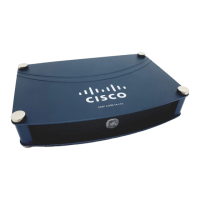14-8
User Guide for Cisco Digital Media Player Device Manager 5.2.x
OL-15764-03
Chapter 14 Configure Video and Audio Settings
Reference
UI Reference: Elements to Define Jitter Buffer (Advanced Multicast) Settings
Table 14-4 Elements on the Advanced Multicast Page
Element Description
When the DMPDM navigation path on your DMP is Settings > Advanced Multicast
Enable Automatic
STC Adjustment
Indicates whether STC adjustment is automated.
Jitter Drifting Indicates the rate of drift, as measured in 50-millisecond increments. Choose an option from
th
e list. Options range incrementally from exactly 50 ms to
exactly 1500 ms, after which the
one additional option is > 1500 ms.
The factory-default value is 1500 ms.
50 ms is the best possible condition.
Multicast Pre-buffer Time
(
0-2200)
Counts in milliseconds how long the pre-buffer should endure, per PTS. Enter 0 (zero) to use
no pre-buffer.
When the DMPDM navigation path on your DMP is Settings > Video
Low Mark of (PTS-STC) (ms) Media playback duration (in milliseconds) that specifies the smallest permissible buffer size.
This value and the High Mark value define the low and high thresholds, respectively, for your
DMP’s jitter buffer. The actual buffer size might reach either extreme but is more likely to
straddle a midpoint.
Except when nothing at all is buffered, this is the least amount of media that will buffer en
r
oute to its decoding. Buffer size is proportionate to latency, so a larger buffer
proportionately improves the capacity for jitter control.
Whenever your presentation system is one tile in a video wall — or feeds signals to other tiles
v
ia RS-232 daisy-chaining — this value should be within 100 ms of the High Mark value.
O
therwise, the tiles in your video wall might fall out of sync.
High Mark of (PTS-STC) (ms) Media playback duration (in milliseconds) that specifies the largest permissible buffer size.
Th
is value and the Low Mark value define the high and low thresholds, respectively, for your
DMP’s jitter buffer. The actual buffer size might reach either extreme but is more likely to
straddle a midpoint.
The buffer will never hold any more media than this. Buffer size is proportionate to latency,
so
a larger buffer proportionately improves the capacity for jitter control.
Whenever your presentation system is one tile in a video wall — or feeds signals to other tiles
v
ia RS-232 daisy-chaining — this value should be within 100 ms of the Low Mark value.
O
therwise, the tiles in your video wall might fall out of sync.
Time of Calculating Average
(P
TS-STC) (sec)
Interval (in seconds) that your DMP reserves to calculate the average size of its own jitter
buffer and adjust the STC, as needed to alter the data size.
In most case, 60 seconds works well.
Statistics of (PTS-STC) Click Displa
y to view information about your DMP’s jitter buffer.

